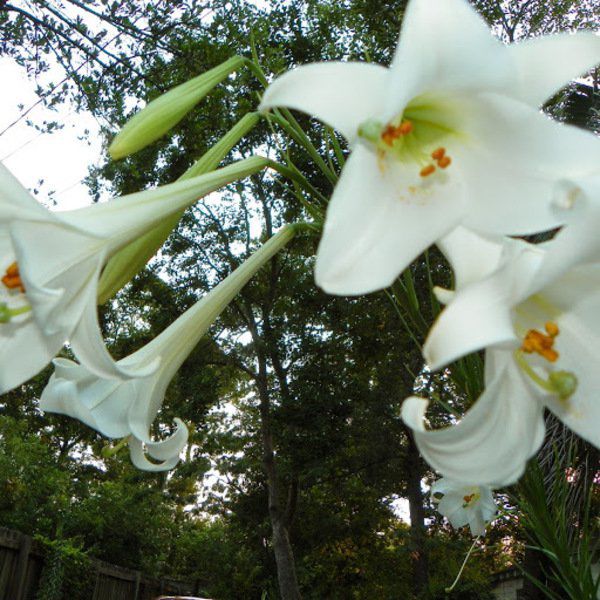Lilies are thriving during summer heat
Published 9:00 am Sunday, August 4, 2019

- Submitted photoFormosa lilies in bloom.
We are entering the first full week of August. It is hot, sticky and sweltering outside. Apparently, weeds love this weather as they seem to be thriving. We also have domesticated plants that have moved over to growing wild and free on their own.
Formosa lilies are just finishing their long bloom time. The tall graceful, single stem plants look just like an Easter lily when flowering, but grow much taller and have slimmer foliage.
The pure white lilies grow atop the stem in a whorl of petals dusted with golden pollen. The number of flowers per stem depends on the size and maturity of the plant. One to 10 lovely trumpets may adorn the stem.
Queen lilies, as they are also called, spread easily on their own when they find the right conditions. Each flower produces a seed pod three to four inches long. There are several rows of seed packed inside each pod, small papery disc-like seed that spread on animals, wind and float on moving rain water. The lilies like sun, but need support for their tall stem.
So, they are often seen growing along the edges of fields where they have naturalized and produce thousands of seed that find a good spot to grow and another perennial is started and they just keep on spreading.
Beauty berry, Callicarpa americana, is a small native shrub that is flowering now with groups of small white flowers along its stems. Pollinators, butterflies, bees, native bees, hummingbirds and wasps who prey on insects, are attracted to beauty berry. As the flowers fade, they will be replaced by clusters of bright neon purple berries that last on the shrubs for a few months, until they are eaten by wildlife in winter.
Beauty berry also spreads easily through the masses of seed produced. They grow along roadsides, fence rows, old fields and understory growth in thin forests. This is a good specimen plant for a bright spot of purple color in fall. Some catalogs list a two-quart size plant from $20 to $30.
Here, they grow all along roads in the county.
They will volunteer and seedlings come up in your garden from wildlife. If you know what to look for, they are easily pulled when small, if unwanted.
Do not worry about them becoming invasive. They are not that abundant. I have several in different areas and cut them back in winter, after the berries are eaten. They can be pruned any time through June and still produce flowers and berries as they bloom on new wood. There is also a white-berried one, but it is not vivid like the purple.
Summer annuals are bright and pretty as we roll into August. Bold yellow and gold marigolds and brilliant red salvias produce wow power in any bed.
Gerberas, geraniums and petunias often take a break from flowering in intense heat. They will perk up when days drop into the 80s instead of high 90s.
Mums will be forming buds for fall bloom. Do not pinch or prune them anymore, to avoid removing forming flower buds. Cuttings can be taken from perennials. They will root by late fall, when they can be planted in the garden to increase your stock or to replace older plants that are getting too woody for best bloom.
When cutting perennials or shrubs back, remove oldest woody stems near the base of the plant to promote strong new growth. Open centers of plants allowing sunlight and air to reach the interior of shrubs to keep foliage from dropping off and creating a woody leafless center.
Check gardenias, hibiscus plants, Japanese magnolia trees and other ornamentals for whiteflies. Shake the bush or branches, if a swarm of small whiteflies fly into the air, they are hiding on the underside of the foliage.
Whiteflies are a problem on many vegetables and on cotton as well. They are everywhere in the environment and will usually find your plants. They damage by sucking the plants juices and cause the plant to be weak. They also have a crawler stage and the immature crawlers suck the plant’s sap too.
Gardenias will develop sooty mold on the surface of their foliage, if whiteflies are present. The mold grows on the droppings from the whiteflies living on the underside of leaves above the ones with sooty mold. The dark ugly mold keeps leaves from absorbing sunlight and weakens the plant as well as looking unsightly.
Mealy bugs appear on container-grown and garden plants. They look like a tiny speck of cotton or fuzz on the joints of branches or leaf nodes on plants. They are also a sucking insect and will easily damage plants.
If you only find a few, they can be removed with a Q-tip dipped into alcohol. An infestation the plant will need to be sprayed with an insecticide labeled for mealy bugs.
We have about two more months of really hot days ahead of us, maybe slightly cooler nights in late September, but with global warming that is not assured.
Try to keep cool.
Remember, if you have a heat stroke and can’t keep your garden up, everything will go to weeds without you.
See you next week.





